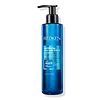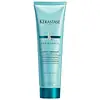What's inside
What's inside
 Benefits
Benefits

 Concerns
Concerns

 Ingredients Side-by-side
Ingredients Side-by-side

Water
Skin ConditioningCetearyl Alcohol
EmollientParaffinum Liquidum
EmollientStearyl Alcohol
EmollientParfum
MaskingGlycerin
HumectantBehentrimonium Chloride
PreservativeCetrimonium Chloride
AntimicrobialAmodimethicone
Sodium Benzoate
MaskingIsopropyl Alcohol
SolventHydrolyzed Wheat Protein
Skin ConditioningCitric Acid
BufferingTourmaline
Hydrolyzed Corn Protein
Skin ConditioningHydrolyzed Soy Protein
HumectantTrideceth-6
EmulsifyingChlorhexidine Dihydrochloride
AntimicrobialBenzyl Benzoate
AntimicrobialLimonene
PerfumingBenzyl Alcohol
PerfumingLinalool
PerfumingPhenoxyethanol
PreservativeWater, Cetearyl Alcohol, Paraffinum Liquidum, Stearyl Alcohol, Parfum, Glycerin, Behentrimonium Chloride, Cetrimonium Chloride, Amodimethicone, Sodium Benzoate, Isopropyl Alcohol, Hydrolyzed Wheat Protein, Citric Acid, Tourmaline, Hydrolyzed Corn Protein, Hydrolyzed Soy Protein, Trideceth-6, Chlorhexidine Dihydrochloride, Benzyl Benzoate, Limonene, Benzyl Alcohol, Linalool, Phenoxyethanol
Water
Skin ConditioningCyclopentasiloxane
EmollientPropylene Glycol
HumectantDimethiconol
EmollientTriethanolamine
BufferingPhenoxyethanol
PreservativePEG/PPG-17/18 Dimethicone
EmulsifyingCarbomer
Emulsion StabilisingBehentrimonium Chloride
PreservativePolyquaternium-4
Potato Starch Modified
Hydroxypropyl Guar
Emulsion StabilisingMethylparaben
PreservativeLimonene
PerfumingAmodimethicone
Cetyl Alcohol
EmollientQuaternium-87
CleansingBehentrimonium Methosulfate
Quaternium-33
Trideceth-6
Emulsifying2-Oleamido-1,3-Octadecanediol
Skin ConditioningGeraniol
PerfumingLinalool
PerfumingGlycerin
HumectantCitronellol
PerfumingCitral
PerfumingCetrimonium Chloride
AntimicrobialTrehalose
HumectantTamarindus Indica Seed Polysaccharide
Skin ConditioningMyrothamnus Flabellifolia Leaf Extract
EmollientParfum
MaskingWater, Cyclopentasiloxane, Propylene Glycol, Dimethiconol, Triethanolamine, Phenoxyethanol, PEG/PPG-17/18 Dimethicone, Carbomer, Behentrimonium Chloride, Polyquaternium-4, Potato Starch Modified, Hydroxypropyl Guar, Methylparaben, Limonene, Amodimethicone, Cetyl Alcohol, Quaternium-87, Behentrimonium Methosulfate, Quaternium-33, Trideceth-6, 2-Oleamido-1,3-Octadecanediol, Geraniol, Linalool, Glycerin, Citronellol, Citral, Cetrimonium Chloride, Trehalose, Tamarindus Indica Seed Polysaccharide, Myrothamnus Flabellifolia Leaf Extract, Parfum
 Reviews
Reviews

Ingredients Explained
These ingredients are found in both products.
Ingredients higher up in an ingredient list are typically present in a larger amount.
This water-soluble silicone is used for its hydrating and softening properties. It is used to add a silky feel to skincare products and has great benefits for haircare.
In haircare, this ingredient:
- Adds shine
- Protects color
- Offers thermal protection
- Boosts hair strength
- Does not build up as easily
This ingredient is a preservative and often used for it's anti-static properties. You'll most likely see this ingredient in hair conditioners.
It does not cause irritation or sensitization in leave-on products at 1-5%.
This ingredient is a preservative, antimicrobial, and emulsifier. It is often used in cosmetics for its ability to cleanse, condition, and reduce static.
Cetrimonium chloride is a quaternary ammonium salt, meaning it has a water-soluble structure.
Glycerin is already naturally found in your skin. It helps moisturize and protect your skin.
A study from 2016 found glycerin to be more effective as a humectant than AHAs and hyaluronic acid.
As a humectant, it helps the skin stay hydrated by pulling moisture to your skin. The low molecular weight of glycerin allows it to pull moisture into the deeper layers of your skin.
Hydrated skin improves your skin barrier; Your skin barrier helps protect against irritants and bacteria.
Glycerin has also been found to have antimicrobial and antiviral properties. Due to these properties, glycerin is often used in wound and burn treatments.
In cosmetics, glycerin is usually derived from plants such as soybean or palm. However, it can also be sourced from animals, such as tallow or animal fat.
This ingredient is organic, colorless, odorless, and non-toxic.
Glycerin is the name for this ingredient in American English. British English uses Glycerol/Glycerine.
Learn more about GlycerinLimonene is a fragrance that adds scent and taste to a formulation.
It's found in the peel oil of citrus fruits and other plants such as lavender and eucalyptus. The scent of limonene is generally described as "sweet citrus".
Limonene acts as an antioxidant, meaning it helps neutralize free radicals.
When exposed to air, oxidized limonene may sensitize the skin. Because of this, limonene is often avoided by people with sensitive skin.
The term 'fragrance' is not regulated in many countries. In many cases, it is up to the brand to define this term. For instance, many brands choose to label themselves as "fragrance-free" because they are not using synthetic fragrances. However, their products may still contain ingredients such as essential oils that are considered a fragrance.
Learn more about LimoneneLinalool is a fragrance and helps add scent to products. It's derived from common plants such as cinnamon, mint, citrus, and lavender.
Like Limonene, this ingredient oxidizes when exposed to air. Oxidized linalool can cause allergies and skin sensitivity.
This ingredient has a scent that is floral, spicy tropical, and citrus-like.
Learn more about LinaloolParfum is a catch-all term for an ingredient or more that is used to give a scent to products.
Also called "fragrance", this ingredient can be a blend of hundreds of chemicals or plant oils. This means every product with "fragrance" or "parfum" in the ingredients list is a different mixture.
For instance, Habanolide is a proprietary trade name for a specific aroma chemical. When used as a fragrance ingredient in cosmetics, most aroma chemicals fall under the broad labeling category of “FRAGRANCE” or “PARFUM” according to EU and US regulations.
The term 'parfum' or 'fragrance' is not regulated in many countries. In many cases, it is up to the brand to define this term.
For instance, many brands choose to label themselves as "fragrance-free" because they are not using synthetic fragrances. However, their products may still contain ingredients such as essential oils that are considered a fragrance by INCI standards.
One example is Calendula flower extract. Calendula is an essential oil that still imparts a scent or 'fragrance'.
Depending on the blend, the ingredients in the mixture can cause allergies and sensitivities on the skin. Some ingredients that are known EU allergens include linalool and citronellol.
Parfum can also be used to mask or cover an unpleasant scent.
The bottom line is: not all fragrances/parfum/ingredients are created equally. If you are worried about fragrances, we recommend taking a closer look at an ingredient. And of course, we always recommend speaking with a professional.
Learn more about ParfumPhenoxyethanol is a preservative that has germicide, antimicrobial, and aromatic properties. Studies show that phenoxyethanol can prevent microbial growth. By itself, it has a scent that is similar to that of a rose.
It's often used in formulations along with Caprylyl Glycol to preserve the shelf life of products.
We don't have a description for Trideceth-6 yet.
Water. It's the most common cosmetic ingredient of all. You'll usually see it at the top of ingredient lists, meaning that it makes up the largest part of the product.
So why is it so popular? Water most often acts as a solvent - this means that it helps dissolve other ingredients into the formulation.
You'll also recognize water as that liquid we all need to stay alive. If you see this, drink a glass of water. Stay hydrated!
Learn more about Water